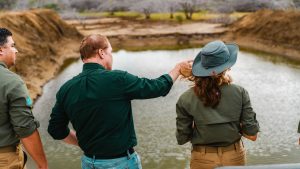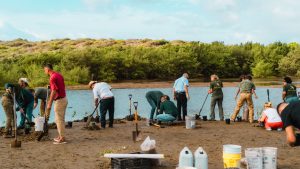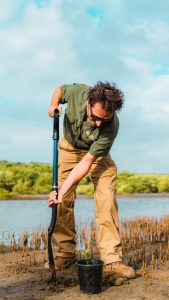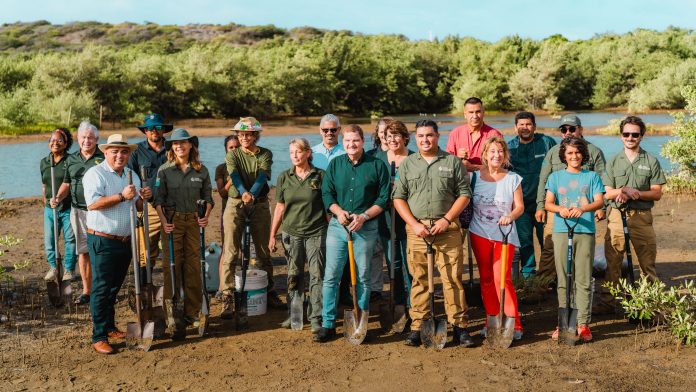(Oranjestad)—The Aruba Conservation Foundation (ACF), an independent conservation management organization, and Ban Lanta y Planta (BLyP), an organization dedicated to planting native trees to restore Aruba’s ecosystem, joined forces to contribute to the improvement of Aruba’s nature in celebration of Earth Day. As part of this collaboration, employees and volunteers from ACF and BLyP came together for a small activity to share knowledge and give back to Mother Earth by planting 28 mangrove trees grown by ACF and BLyP themselves.
This meaningful occasion began with the active participation of Prime Minister Mike Eman, together with the Director of the Directorate of Nature & Environment, Gisbert Boekhoudt. The team demonstrated the full process of germinating mangrove seedlings. Next, they will evaluate the survival of the plants in nature to continue improving the process of propagation and nurturing both types of trees in designated areas, and later replant them in nature. This is to begin restoring degraded areas of native plant biodiversity.
What types of mangroves were planted and why?
A total of 28 mangrove trees were planted, consisting of two different species: Avicennia germinans, commonly known as Black Mangrove, and Conocarpus erectus, better known locally as Fofoti.
The Black Mangrove typically grows on the edges of salt flats and near brackish water, but it prefers slightly drier habitats because it sometimes struggles to get oxygen when soil is clay-heavy or underwater. The solution is that it grows special aerial roots called pneumatophores, which allow the tree to breathe – like snorkels. You can recognize Black Mangroves by the salt residue found on the underside of their leaves.
The Fofoti is Aruba’s iconic tree that tolerates high salinity but prefers to grow near the edges of salt flats or slightly higher and drier areas compared to the Black Mangrove.

Why these mangrove species?
ACF and Ban Lanta y Planta are experimenting with germination and optimal growth conditions for all mangrove species found in Aruba. The goal is to maximize the potential to plant more mangroves in the future. They were fortunate to have suitable weather conditions, and the young mangroves were ready to be planted on Earth Day, marking the start of this collaboration.
Location: Spaans Lagoen
These 28 mangroves were planted in the protected area of Spaans Lagoen, in locations identified as suitable for the species and currently being restored as part of the European Union-funded RESEMBID program project, “Turning the Tide.”
The planted mangroves will be monitored in the coming months for growth and survival. It’s important to note that restoring mangroves doesn’t just mean planting new ones. Under the “Turning the Tide” pilot project, analysis showed that environmental conditions – like water flow – also need to be restored. At Spaans Lagoen, canals are currently being restored to allow the mangroves in the area to grow healthily. The ultimate goal is for the ecosystem to one day restore itself naturally, without the need to plant new mangroves.
What can individuals do to help the health of Aruba’s mangrove forests?
Globally, mangroves are under threat, and in Aruba, almost 90% of the island’s mangroves have disappeared in the past decade. Since 2017, all mangrove species in Aruba are protected by law (AB 2017 no. 48) and also internationally under the SPAW Protocol Annex III.
It is crucial for the community to understand the vital role mangroves play as habitats for small animals like crabs and juvenile fish, and as areas where fish and shrimp feed. They also provide nesting grounds for birds and other animals. Mangrove roots are essential breeding areas for creatures like crabs and oysters, and in turn, they support millions of people. Mangroves also filter runoff water from land before it enters the ocean, preventing sea grass and coral reefs from being smothered by sediment. Finally, mangroves provide coastal protection during storms.
It’s important to respect mangrove forests. Do not cut or remove mangroves, and do not throw trash into them. Keep a respectful distance and allow mangroves space to fulfill their essential role in nature.
ACF and BLyP’s Commitment
ACF and BLyP remain committed to restoring Aruba’s nature with native trees to support biodiversity and climate resilience. With the planting of these young mangroves on Earth Day, they hope to learn how to plant more in the future to enhance natural restoration.
To get to know the mangrove species better, you can visit the ACF greenhouse located at San Fuego 70, or the Ban Lanta y Planta nursery in Paraguana, Noord.
For more information, you can contact Aruba Conservation Foundation at info@acf.aw, visit their social media pages on Facebook or Instagram, or contact Ban Lanta y Planta at banlantayplanta@gmail.com.




















